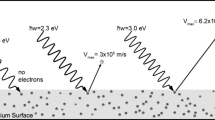Summary
The convergence of the expestation value\(\bar N\) of the number of soft photons emitted by a given classical current is studied, using Bloch and Nordsieck’s approximation. It is found thatN is finite, whenever the particles producing the field are moving in a finite volume of space. Therefore in every experiment that can really be done the number of emitted photons is finite. Bloch and Nordsieck’s divergence, which arises in the case of a charged particle undergoing a transition between two definite momentum states, corresponds to experimental conditions which can not be reached in nature (an infinite volume of space is necessary). In the Appendix a less stringent condition for the convergence of\(\bar N\) is derived.
Riassunto
Si studia qui la convergenza del numero medioN di fotoni di bassa energia emesso da una assegnata distribuzione classica di corrente, usando l’approssimazione di Bloch e Nordsieck. Si sono ricavate condizioni sufficienti perchèN sia finito. La più immediata assicura che\(\bar N\) è finito ogniqualvolta le cariche che producono il campo si muovono in un volume finito di spazio. Perciò in ogni esperimento realmente effettuabile il numero di fotoni emessi è finito. Un’altra condizione sufficiente per la convergenza di\(\bar N\), dedotta nell’Appendice, è che la velocità delle cariche tenda a 0 con una potenzaɛ < 0 del tempo, quando questo tende a ± ∞. Seɛ = 0 la convergenza diN non è più garantita: ricade in questo caso il moto di una carica che passa da uno stato ad un altro di impulsi determinati. In quest’esempio, studiato da Bloch e Nordsieck, è noto che\(\bar N\) diverge. Però esso corrisponde a condizioni sperimentali che non possono essere realizzate in natura (volume infinito dello spazio necessario).
Similar content being viewed by others
References
W. Thirring andB. Touschek:Phil. Mag.,42, 245 (1951).
In these two examples the formula (9) includes an integral of the form ∫d|k| |k|δ 2(|k|). The symbolδ 2(x) has in general no meaning (seeL. Schwartz:Théorie des distributions (Paris, 1950), vol. I, p. 115). It is easy to see however, that all the rules of calculation can be applied tof(x)δ 2(x), providedf(0) — 0.
Author information
Authors and Affiliations
Rights and permissions
About this article
Cite this article
Ascoli, R. On Bloch and Nordsieck’s divergence. Nuovo Cim 2, 413–417 (1955). https://doi.org/10.1007/BF02826499
Received:
Published:
Issue Date:
DOI: https://doi.org/10.1007/BF02826499




